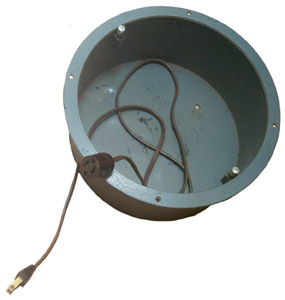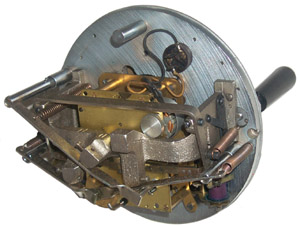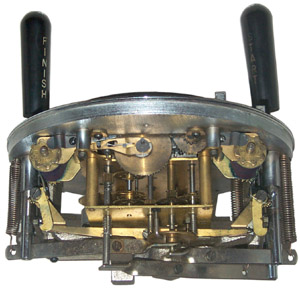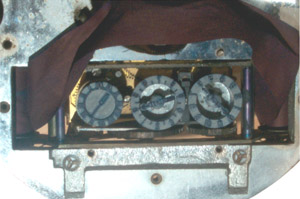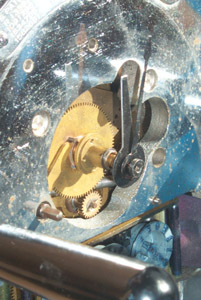Calculagraph
© Brooke Clarke 2008 - 2022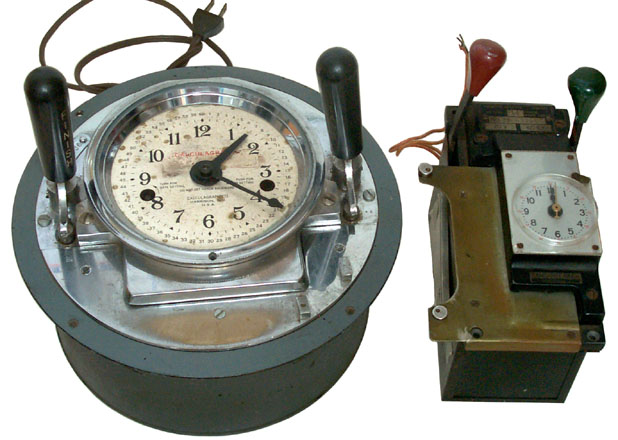
Model 110 Model 33
Background
Prior to the Calculagraph when
the elapsed time was needed, like for phone calls or workers
time cards, a manual procedure was followed. The
starting time was hand printed on a card and then the ending
time was hand printed. A clerk would subtract to find
the elapsed time. About 20% of the time the clerk made a
math error. The Calculagraph prints the start time and
the elapsed time so no calculations are needed. Note no
math is done in the Calculagraph it just prints the elapsed
time dials at the start and the elapsed time pointers at the
end. They were used all over the world.
Calculagraph patent 583320 issued May 25, 1897 by Henry Abbott. This was one of the first time printers. An early use was in pool halls where a ticket would be printed using the start lever and when the table was no longer being used by the stop lever. Inspection would show the elapsed time (or optionally the dollar amount would be printed). This may have been the origin of the expression "Time is Money". The round style unit shown above is based on this patent. The plating at the front of the model 110 has been worn away indicating that this unit has seen a lot of use. It would be nice to know where that happened.
A later application was for timing phone calls where the Model 33 shown at the right above was used in a similar manner. That's to say the operator would insert a card and stamp the time when the call started then stamp it again when the call ended. Note that the Model 33 is only connected to a power source, not the phone lines so the accuracy of the timing depended on the operator. By 1904 Henry has patents for telephone call timers that are coupled to the phone lines, but the Model 33 was patented in 1941 and was widely used. So maybe the 1904 type call timers were not actually used.
The Model 30 looks very much like the model 110. It has a 5 3/4 " diameter clock face, the handles are about 1" in diameter. and the can that covers the bottom is about 9" in diameter that goes into the switchboard position shelf. The IBM mark sense cards were the same size as the standard punched card 7 1/2" X 3 1/4" as I measured them crudely.
Google Image search has many photos of these as well as the other products with the same name.
Calculagraph patent 583320 issued May 25, 1897 by Henry Abbott. This was one of the first time printers. An early use was in pool halls where a ticket would be printed using the start lever and when the table was no longer being used by the stop lever. Inspection would show the elapsed time (or optionally the dollar amount would be printed). This may have been the origin of the expression "Time is Money". The round style unit shown above is based on this patent. The plating at the front of the model 110 has been worn away indicating that this unit has seen a lot of use. It would be nice to know where that happened.
A later application was for timing phone calls where the Model 33 shown at the right above was used in a similar manner. That's to say the operator would insert a card and stamp the time when the call started then stamp it again when the call ended. Note that the Model 33 is only connected to a power source, not the phone lines so the accuracy of the timing depended on the operator. By 1904 Henry has patents for telephone call timers that are coupled to the phone lines, but the Model 33 was patented in 1941 and was widely used. So maybe the 1904 type call timers were not actually used.
The Model 30 looks very much like the model 110. It has a 5 3/4 " diameter clock face, the handles are about 1" in diameter. and the can that covers the bottom is about 9" in diameter that goes into the switchboard position shelf. The IBM mark sense cards were the same size as the standard punched card 7 1/2" X 3 1/4" as I measured them crudely.
Google Image search has many photos of these as well as the other products with the same name.
References
The following description
from The
Clocksmith is for the first wind up version:
The following is from Page's Engineering Weekly Published by The Page Publishing Syndicate, Limited., 1904:
It shows the round type Calculagraph positioned between two switch boards so that two operators can share using it. It mentioned that you can get either spring wound or electrical drive versions.
A description by Roger Conklin (who supplied the above article) 10 sep 2008 is:
CALCULAGRAPH made by the
Calculagraph Co. in New York, N.Y. USA.
The movement is a Seth Thomas #10 (work horse) 8 day double spring balance movement.
[bc note: this is very similar if not the same as the movement used in the "Western Union" Self Winding Clocks]
The dial is white fired enamel with Roman numerals and Arabic 5 minute numerals.
The bezel is iftted with thick beveled glass that is badly scratched and scarred.
The case is sleek painted silver. One brass plaque across the top has
“CALCULAGRAPH- US PATENTS NOS. 424.291, 424.292, 449.192, 583.320, 679.408, 697.426, 697.427 TRADEMARK SEPT. 13, 1892, NO.21747.
The other plaque under the dial has:
“9611-CANADIAN AND EUROPEAN PATENTS”.
It was apparently used to bill long distance phone calls or any activity that needed to be time measured. 9” round 9 ˝” tall
[bc note: the last patent was issued in 1902 so the wind up model was being used then.]
Note that Henry Abbott has a number of patents covering
methods of making enamel watch and clock dials which were used
for the Calculagraph. The movement is a Seth Thomas #10 (work horse) 8 day double spring balance movement.
[bc note: this is very similar if not the same as the movement used in the "Western Union" Self Winding Clocks]
The dial is white fired enamel with Roman numerals and Arabic 5 minute numerals.
The bezel is iftted with thick beveled glass that is badly scratched and scarred.
The case is sleek painted silver. One brass plaque across the top has
“CALCULAGRAPH- US PATENTS NOS. 424.291, 424.292, 449.192, 583.320, 679.408, 697.426, 697.427 TRADEMARK SEPT. 13, 1892, NO.21747.
The other plaque under the dial has:
“9611-CANADIAN AND EUROPEAN PATENTS”.
It was apparently used to bill long distance phone calls or any activity that needed to be time measured. 9” round 9 ˝” tall
[bc note: the last patent was issued in 1902 so the wind up model was being used then.]
The following is from Page's Engineering Weekly Published by The Page Publishing Syndicate, Limited., 1904:
The Calculagraph and its
Functions.
The manufacturers who devised the calculagraph have made a great advance on all other systems of time recording. The ingenious calculagraph saves 50 per cent or more of the time clerk's work by registering the time at which the job commenced, and mechanically subtracting this from the time of finishing; the difference or time elapsed is then printed in hours and minutes on the card dropped into the slot.
The Calculagraph makes no clerical errors, and can be manipulated by anyone. It is only necessary to push a card into the slot and pull a lever, and the number of calculations this clever machine can make is only limited by the number of cards it is possible to push consecutively into the slot during a given time.
. . . .
Special calculagraphs can also be had for industries or factories where the rate of pay per hour is uniform in the department, which print the value of the elapsed time in (pounds Sterling), s. d. or other coinage. The calculagraph therefore, obviates all necessity for clerical work on the part of the workman, besides saving half that of the time clerk. . . . .
The January 1928 issue of Electrical Communication published
by International Standard Electric Corp is an article titled:
The CalculagraphThe manufacturers who devised the calculagraph have made a great advance on all other systems of time recording. The ingenious calculagraph saves 50 per cent or more of the time clerk's work by registering the time at which the job commenced, and mechanically subtracting this from the time of finishing; the difference or time elapsed is then printed in hours and minutes on the card dropped into the slot.
The Calculagraph makes no clerical errors, and can be manipulated by anyone. It is only necessary to push a card into the slot and pull a lever, and the number of calculations this clever machine can make is only limited by the number of cards it is possible to push consecutively into the slot during a given time.
. . . .
Special calculagraphs can also be had for industries or factories where the rate of pay per hour is uniform in the department, which print the value of the elapsed time in (pounds Sterling), s. d. or other coinage. The calculagraph therefore, obviates all necessity for clerical work on the part of the workman, besides saving half that of the time clerk. . . . .
It shows the round type Calculagraph positioned between two switch boards so that two operators can share using it. It mentioned that you can get either spring wound or electrical drive versions.
A description by Roger Conklin (who supplied the above article) 10 sep 2008 is:
Brooke,
Attached is the article from the Jan. 1928 issue of Electrical Communications. This was published by IT&T in New York.
Before the Calculagraph, the operators noted the start time and stop time from a clock on the wall on a paper ticket and then subtracted the former from the latter to determine the minutes and seconds elapsed for calculating the charge on the call. Normally there was a basic rate for the first 3 minutes and a per-minute overtime rate for each additional minute, or fraction thereof. The extra-minute rate was usually about 1/3 of the basic 3-minute minimum rate.
Because there were many calls at progress at any one time, and because a single Calculagraph normally served two complete switchboard positions, there was no way to associate a specific call in progress with the Calculagraph. That would have required a Calculagraph for each connecting cord circuit. There were normally at least 10 cord circuits for each operator on every switchboard position, which meant that there could be 20 calls requiring timing in progress when all 10 cord circuits on the two positions were connected. Stamping each toll ticket when the call started, and again when it was completed, allowed a single Calculagraph to do the time recording for many calls. While the call was in progress, the toll ticket was stored temporarily in a slot in the keyshelf associated with the particular cord pair over which the call was being completed. That way the operator knew quickly which toll ticket to slip into the Calculagraph and pull the handle when the call was completed. Accuracy was dependent on the operator being very prompt in stamping the toll tickets when conversation began and when it terminated. It was only as accurate as the operator was fast.
Also, on magneto switchboards, there was no sure electrical signal when the called party answered or when the parties hung up. Subscribers were supposed to "ring off" when they completed a call to tell the operator the call was over, but they often forgot to do that. The operator had to constantly be monitoring the calls to determine when each call was completed and then quickly stick the toll ticket into the Calculagraph to stamp completion. She would open her listening key just long enough to make sure the parties were still talking. If she heard no conversation, she would ask "Are you through?" If there was no response, she knew the call was done and proceed to stamp the toll ticket in the Calculagraph. It was a very "manual" process.
I have seen L M Ericsson toll switchboards, made in Sweden, for common battery and automatic dial toll service where, instead of a Calculagraph there was actually a meter mounted in the switchboard keyshelf, one for each cord pair, which was electrically operated to start counting elapsed time when the answer lamp went out (when the called party answered) and stopped counting when either party hung up. This was electrically operated. The operator then read the elapsed time from the meter and noted it on the toll ticket. This elapsed time was used to manually calculate the charge for the call. This was a more accurate method, but required a much greater investment than did the Calculagraph.
It wasn't until TSPS cordless toll switchboards came along that timing actuated by the subscriber's hanging up was employed to determine elapsed time on long distance calls. This is when call billing data started being recorded on punched paper tape rather than on individual paper toll tickets.
Roger
Attached is the article from the Jan. 1928 issue of Electrical Communications. This was published by IT&T in New York.
Before the Calculagraph, the operators noted the start time and stop time from a clock on the wall on a paper ticket and then subtracted the former from the latter to determine the minutes and seconds elapsed for calculating the charge on the call. Normally there was a basic rate for the first 3 minutes and a per-minute overtime rate for each additional minute, or fraction thereof. The extra-minute rate was usually about 1/3 of the basic 3-minute minimum rate.
Because there were many calls at progress at any one time, and because a single Calculagraph normally served two complete switchboard positions, there was no way to associate a specific call in progress with the Calculagraph. That would have required a Calculagraph for each connecting cord circuit. There were normally at least 10 cord circuits for each operator on every switchboard position, which meant that there could be 20 calls requiring timing in progress when all 10 cord circuits on the two positions were connected. Stamping each toll ticket when the call started, and again when it was completed, allowed a single Calculagraph to do the time recording for many calls. While the call was in progress, the toll ticket was stored temporarily in a slot in the keyshelf associated with the particular cord pair over which the call was being completed. That way the operator knew quickly which toll ticket to slip into the Calculagraph and pull the handle when the call was completed. Accuracy was dependent on the operator being very prompt in stamping the toll tickets when conversation began and when it terminated. It was only as accurate as the operator was fast.
Also, on magneto switchboards, there was no sure electrical signal when the called party answered or when the parties hung up. Subscribers were supposed to "ring off" when they completed a call to tell the operator the call was over, but they often forgot to do that. The operator had to constantly be monitoring the calls to determine when each call was completed and then quickly stick the toll ticket into the Calculagraph to stamp completion. She would open her listening key just long enough to make sure the parties were still talking. If she heard no conversation, she would ask "Are you through?" If there was no response, she knew the call was done and proceed to stamp the toll ticket in the Calculagraph. It was a very "manual" process.
I have seen L M Ericsson toll switchboards, made in Sweden, for common battery and automatic dial toll service where, instead of a Calculagraph there was actually a meter mounted in the switchboard keyshelf, one for each cord pair, which was electrically operated to start counting elapsed time when the answer lamp went out (when the called party answered) and stopped counting when either party hung up. This was electrically operated. The operator then read the elapsed time from the meter and noted it on the toll ticket. This elapsed time was used to manually calculate the charge for the call. This was a more accurate method, but required a much greater investment than did the Calculagraph.
It wasn't until TSPS cordless toll switchboards came along that timing actuated by the subscriber's hanging up was employed to determine elapsed time on long distance calls. This is when call billing data started being recorded on punched paper tape rather than on individual paper toll tickets.
Roger
Factory
Organization
and
Administration By Hugo Diemer, Third edition
1921 describes using the Calculagraph for timing workers.
The time card size is 3" by 5" hence
the common 3x5 card that's still available today in any
stationary store today because they were printed by the
millions for the Calculagraph.
Judicial and Statutory Definitions of Words and Phrases By West Publishing Company, Vol 1, 1914
A "Calculagraph" is an
instrument for automatically recording lapsed time and is
used specifically in recording the length of time a long
distance telephone has been used by the operation of a lever
at the beginning and end of such use, and also the time of
day when such use was commenced. Calculagraph Co. v.
Wilson, 132 Fed. 20, 22.
Henry Abbott
Henry worked as a watch-smith in
New York. At that time the import duty on watch parts
was lower than on complete watches, so he imported the parts
and assembled watches. Prior to inventing the
Calculagraph he invented a way to convert a watch from needing
a key to wind to to using the stem for both winding and
setting the hands. With his invention key wind watch
movements could be converted to stem wind making them more
desirable (valuable).
Description
Round Model 110 Calculagraph
The key idea is that when the start lever is pressed back it prints the graphical clock showing the start time and when pulled forward it prints the two outer circles that will show the elapsed time (not the stop time). When the card is again inserted and the stop lever is moved back and forward it prints the arrows in the elapsed time circles. Note that the arrow always points to the zero position of the circle, but they are printed at different times so show the elapsed time.There are two holes in face as shown in the photo at the top of the page. In the left "day of month" hole is a square post that can be turned with a common clock winding key (3.4 mm size). That same key can be used to press the cylinder under the right hole to advance the months. The Time Savers (#10050) 3.4 mm key fits the square pin, but it too short to work the month advance so a key that's longer would be a better choice. Also the squard pin does not want to turn. Not sure why.
It's not yet clear how the hours and minutes are set.
This is a later version of the original round model. The 583320 patent shows a unit that's powered by a clockwork spring, not an 110 VAC electric motor like this model 110.
1582651 is the 1926 patent for auto reversing the ribbon and this model 110 s/n 52756 has auto reverse on the ribbon.
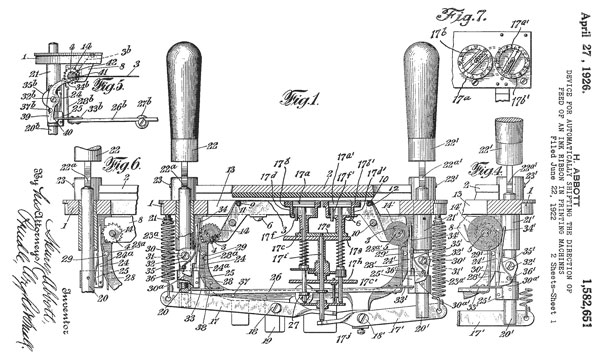
Setting Time & Date
On the visible clock face there are two ways to mount the minute hand to it's shaft and only one of them is correct. The hour hand is a friction fit and needs to be rotated to match the start time small triangular pointer. The minute hand should be installed to match the minute pointer in the start time dial.To set the time turn the visible minute hand clockwise (not counterclockwise) until both the hour and minute hands are showing the correct time.
There is a pin on the hour gear that restricts the movement of the day of month setting key and a little after 12:10 the pin allows full movement of the day of month key so for each CW-CCW cycle of the key the day of month advances one day. Note that the day of month and the month need to be set manually since they are not connected to the clock work.
Key

Jeffrey Lamb of Kingston, Ontario makes a new setting key.
Rectangular Model 33 Calculagraph
The model 33 was made expressly for use on telephone switchboards. It's powered by a 20 VAC electric motor. The narrow rectangular shape allows it to fit on the table part of a switchboard and not take up anywhere as much space as the round model would.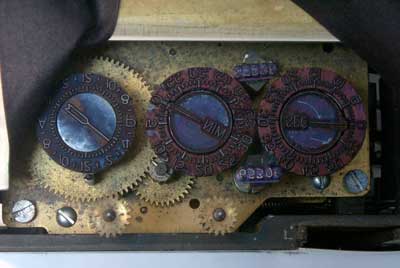 |
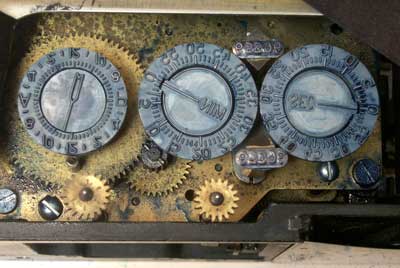 |
| Type
wheels as received. Some characters plugged. |
These
wheels need more cleaning. |
Note that the Model 33 does not have day and date wheels like the Model 110. Less to maintain.
 This is the plate that's just above the
printing wheels. On it's back side is an almost hard
rubber strip that has a give to allow the type wheels to
depress the time card. The Model 110 also has the same
rubber strip under it's top plate.
This is the plate that's just above the
printing wheels. On it's back side is an almost hard
rubber strip that has a give to allow the type wheels to
depress the time card. The Model 110 also has the same
rubber strip under it's top plate.The clock Hour, Minute and Second hands just press on the shaft on the right side gear. No nut is needed like on the Model 110. If this plate is turned upside down the gears will fall out.
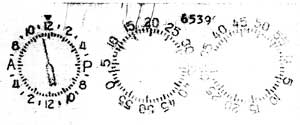 |
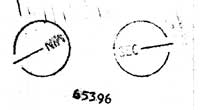 |
Inking
By manually operating the FINISH
lever the ribbon will feed. When the end of travel is
reached the direction is supposed to reverse. But on
both of these a very small drop of oil on the reversing
mechanism was needed to get them to auto reverse.
By applying stamp pad ink just prior to the take up spool you can see the ink from the ribbon that's already on the spool soak through to the new ribbon that's being wound on. If you don't see the ink wetting the new ribbon then add more stamp pad ink.
Note that working any of the levers to advance the ink also puts ink on the rubber platen and that needs to be cleaned before using the Calculagraph.
By applying stamp pad ink just prior to the take up spool you can see the ink from the ribbon that's already on the spool soak through to the new ribbon that's being wound on. If you don't see the ink wetting the new ribbon then add more stamp pad ink.
Note that working any of the levers to advance the ink also puts ink on the rubber platen and that needs to be cleaned before using the Calculagraph.
Bell System Practices
030-101-101
Issue 1, November 1935, Calculagraphs, Electrically Driven
Model 30 and Model 33 Description (30 round case, i.e. same as
110)
030-102-701 KS-7769 Calculagraphs Requirement and Adjusting Procedures, issue 7, April 1969
030-102-701 KS-7769 Calculagraphs Requirement and Adjusting Procedures, issue 7, April 1969
030-102-801 KS-7769
Calculagraphs Piece-Part and Replacement Procedures, issue 6,
Oct 1961
Patents
180739 Winding and Setting
Attachments for Watches, Henry Abbott, Jun 6, 1876, 368/213 ;
968/25 -
193312 Lever Winding and Setting Attachments for Watches, Henry Abbott, Jul 24, 1877, 368/213 -
203524 Improvement in Stem Winding Watches, Henry Abbott, May 14, 1878, 368/196 -
309909 Process of Applying Colors to Enamel Dials of Watcches and Clocks, Henry Abbott, Dec 30, 1884, 156/89.24 ; 156/235; 427/149; 428/426; 428/914
309910 Ornamenting Enameled or Glazed Surfaces, Henry Abbott, Dec 30, 1884, 264/245 ; 264/255; 425/470 -
309911 Ornamenting Enameled or Glazed Surfaces, Henry Abbott, Dec 30, 1884, 156/235 -
309912 Ornamenting Enameled or Glazed Surfaces, Henry Abbott, Dec 30, 1884, 118/500 -
309913 Ornamenting Enameled or Glazed Surfaces, Henry Abbott, Dec 30, 1884, 156/241 ; 428/914
309915 Ornamenting Enameled or Glazed Surfaces, Henry Abbott, Dec 30, 1884, 264/334 ; 156/344; 264/343
310112 Ornamentation of Glazed Enameled Surfaces, Henry Abbott, Dec 30, 1884, 156/89.24 ; 156/155 - stencil method of making clock and watch dials
335731 Stem Winding and Setting Watch, Henry Abbott, Feb 9, 1886, 368/198 -
335732 Stem Winding and Setting Mechanism for Watches, Henry Abbott, Feb 9, 1886, 368/196 - movement well run out of case
335733 Stem Winding and Setting Mechanism for Watches, Henry Abbott, Feb 9, 1886, 368/197 -
424291 Apparatus for Recording Measurements of Time, Emery M. Hamilton (assigned to Henry Abbott), Mar 25, 1890, 346/95 -
432256 Interchangeable Stem-winding-watch Movement, Henry Abbott, Jul 15, 1890, 368/318 -
432290 Interchangeable Stem-winding-watch Movement, Henry Abbott, Jul 15, 1890, 368/318 -
432291 Interchangeable Stem-winding-watch Movement, Henry Abbott, Jul 15, 1890, 368/318 -
437371 Type Writing Machine, Henry Abbott, Sep 30, 1890, 400/666 ; 235/26 - prevents two keys from working at the same time
437372 Type Writing Machine, Henry Abbott, Sep 30, 1890, 400/396 ; 400/405.1; 400/431; 400/454; 400/471- upper & lower case letters with different colors
443032 Inking-pad for Type-writing Machines, Henry Abbott, Dec 16, 1890, 400/471 ; 400/413 -
449191 Platten for Type-writing Machines, Henry Abbott, Mar 31, 1891, 400/657 ; 400/656
449192 Apparatus for Recording Measurements of Time, Space or Quanity, Henry Abbott, Mar 31, 1891, 346/95 ; 346/145 -
486458 Time Stamp, Jacob Ganss, 1892-11-22, -
583320 Calculagraph, Henry Abbott, May 25, 1897, 346/61 - the first Calculagraph
618760 Eyeglasses or Spectacles, Henry Abbott, Jan 31, 1899, 351/149 - these predate the ones in the Movie "The Jerk".
679408 Adjustable Bearing, Henry Abbott, Jul 30, 1901, 74/586 - for the round Calculagraph operating levers
697426 Calculagraph, Henry Abbott, Apr 15, 1902, - increase efficiency and ease of operation of 583320
697427 Calculagraph, Henry Abbott, Apr 15, 1902, 346/145 - table flush mounting using a can (still wind up version)
771853 Telephone Call Recorder, Henry Abbott, Oct 11, 1904, 346/41 ; 346/95; 379/119; 379/140 -
878447 Time Printing Mechanism, Henry Abbott, Feb 4, 1908, 346/61 - Vertical or horizontal mount, printed record contains machine serial number
1175107 Two-Cycle Engine, Henry Abbott, Nov 8, 1913, 60/314 ; 123/65VB; 123/71V -
1283432 Self Starting Synchronous Motor, H.E. Warren (Warren Clock Co), Oct 29, 1918, 310/163 ; 310/126; 310/172
193312 Lever Winding and Setting Attachments for Watches, Henry Abbott, Jul 24, 1877, 368/213 -
203524 Improvement in Stem Winding Watches, Henry Abbott, May 14, 1878, 368/196 -
309909 Process of Applying Colors to Enamel Dials of Watcches and Clocks, Henry Abbott, Dec 30, 1884, 156/89.24 ; 156/235; 427/149; 428/426; 428/914
309910 Ornamenting Enameled or Glazed Surfaces, Henry Abbott, Dec 30, 1884, 264/245 ; 264/255; 425/470 -
309911 Ornamenting Enameled or Glazed Surfaces, Henry Abbott, Dec 30, 1884, 156/235 -
309912 Ornamenting Enameled or Glazed Surfaces, Henry Abbott, Dec 30, 1884, 118/500 -
309913 Ornamenting Enameled or Glazed Surfaces, Henry Abbott, Dec 30, 1884, 156/241 ; 428/914
309915 Ornamenting Enameled or Glazed Surfaces, Henry Abbott, Dec 30, 1884, 264/334 ; 156/344; 264/343
310112 Ornamentation of Glazed Enameled Surfaces, Henry Abbott, Dec 30, 1884, 156/89.24 ; 156/155 - stencil method of making clock and watch dials
335731 Stem Winding and Setting Watch, Henry Abbott, Feb 9, 1886, 368/198 -
335732 Stem Winding and Setting Mechanism for Watches, Henry Abbott, Feb 9, 1886, 368/196 - movement well run out of case
335733 Stem Winding and Setting Mechanism for Watches, Henry Abbott, Feb 9, 1886, 368/197 -
424291 Apparatus for Recording Measurements of Time, Emery M. Hamilton (assigned to Henry Abbott), Mar 25, 1890, 346/95 -
This is the start of printing
a dial face like later used in the Calculagraph
424292
Apparatus for Recording Measurements of Time, Emery M.
Hamilton (assigned to Henry Abbott), Mar 25, 1890, 346/95432256 Interchangeable Stem-winding-watch Movement, Henry Abbott, Jul 15, 1890, 368/318 -
432290 Interchangeable Stem-winding-watch Movement, Henry Abbott, Jul 15, 1890, 368/318 -
432291 Interchangeable Stem-winding-watch Movement, Henry Abbott, Jul 15, 1890, 368/318 -
437371 Type Writing Machine, Henry Abbott, Sep 30, 1890, 400/666 ; 235/26 - prevents two keys from working at the same time
437372 Type Writing Machine, Henry Abbott, Sep 30, 1890, 400/396 ; 400/405.1; 400/431; 400/454; 400/471- upper & lower case letters with different colors
443032 Inking-pad for Type-writing Machines, Henry Abbott, Dec 16, 1890, 400/471 ; 400/413 -
some similarity to the
Calculagraph but clearly different
449190 Tool for Clamping Type to Type-bars, Henry Abbott, Mar
31, 1891, 269/37 ; 269/47 - 449191 Platten for Type-writing Machines, Henry Abbott, Mar 31, 1891, 400/657 ; 400/656
449192 Apparatus for Recording Measurements of Time, Space or Quanity, Henry Abbott, Mar 31, 1891, 346/95 ; 346/145 -
not called a Calculagraph but
is very similar to the round version in patent 583320
579121 Eyeglasses or Spectacles, Henry Abbott, Mar 23, 1897,
351/144 - 486458 Time Stamp, Jacob Ganss, 1892-11-22, -
583320 Calculagraph, Henry Abbott, May 25, 1897, 346/61 - the first Calculagraph
618760 Eyeglasses or Spectacles, Henry Abbott, Jan 31, 1899, 351/149 - these predate the ones in the Movie "The Jerk".
679408 Adjustable Bearing, Henry Abbott, Jul 30, 1901, 74/586 - for the round Calculagraph operating levers
697426 Calculagraph, Henry Abbott, Apr 15, 1902, - increase efficiency and ease of operation of 583320
697427 Calculagraph, Henry Abbott, Apr 15, 1902, 346/145 - table flush mounting using a can (still wind up version)
771853 Telephone Call Recorder, Henry Abbott, Oct 11, 1904, 346/41 ; 346/95; 379/119; 379/140 -
Uses relays connected into the
telephone system to start and stop instead of manual levers
772308
Telephone Meter, Henry Abbott, Oct 11, 1904, 379/119 ; 200/14;
346/95; 377/6 - one meter per phone line, all automatic878447 Time Printing Mechanism, Henry Abbott, Feb 4, 1908, 346/61 - Vertical or horizontal mount, printed record contains machine serial number
RE13597
Time Printing Mechanism, Henry Abbott, Jul 22, 1913, 346/61
- what was changed?
1091786
Card Gate, Henry Abbott, Mar 31, 1914, 101/102 - restricts the
way a card can be inserted into the round lever type
Calculagraph1175107 Two-Cycle Engine, Henry Abbott, Nov 8, 1913, 60/314 ; 123/65VB; 123/71V -
1283432 Self Starting Synchronous Motor, H.E. Warren (Warren Clock Co), Oct 29, 1918, 310/163 ; 310/126; 310/172
Prior to this time clocks were
governed by escapement wheels or pendulums so the
Calculagraph could use this motor starting 1918
1534755
Fastener for Ink Ribbons, Henry Abbott, Apr 21, 1925, 242/584
; 411/457; 411/921 - | 1582651
Device for Automatically Shifting the Direction of
Feed of an Ink Ribbon in Printing Machines, Henry
Abbott, Apr 27, 1926, 101/336 ; 101/102 - This is still the round two lever machine. This Model 110 has the auto ribbon reverse feature so this machine was made after 1926 |
|
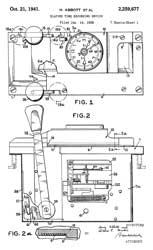 |
2259677 Elapsed Time Recording Device, Henry Abbott, Oct 21, 1941, 346/90 - This is the Model 33 rectangular model for telephone switchboards - setting key Fig 6a |
2796315 Time and Date Printing Mechanism, William C. Moodie (Calculagraph), Jun 18 1957, 346/59 ; 346/82; 346/89 -
3116102 Time clock having charge computing means, Vernon T Kleimeyer, Cincinnati Time Recorder, 1963-12-31, -
Cage Code
| 96784 | CALCULAGRAPH CO |
280 RIDGEDALE AVE 280 EAST HANOVER, NJ 07936 |
973-887-5000 |
Same Name
JSQ-104 Oiling machine
Calculagraph - this is like a car odometer used to record
running time of equipment
THDM700 Heat Pump Water Heater
uses the word Calculagraph in relation to its control system
"LCD Digital Electronic Gage Time Calculagraph For Wii" on eBay is a pedometer (counts each of your steps) that has the look of a small plastic dog bone. Marked Wij Sport Gauge, Beauty-Ping
"LCD Digital Electronic Gage Time Calculagraph For Wii" on eBay is a pedometer (counts each of your steps) that has the look of a small plastic dog bone. Marked Wij Sport Gauge, Beauty-Ping
Links
The
Henry Abbott Papers at the National Association of Watch
and Clock Collectors - has some history on line
The Telephone on P. E. I. - Switchboard /C.O./Service Equipment! by Dave Hunter - has manual for the model 33
Telephone Collectors: The Birth and Early Days of the Calculagraph by Henry Abbott, 1939 -
The Telephone on P. E. I. - Switchboard /C.O./Service Equipment! by Dave Hunter - has manual for the model 33
Telephone Collectors: The Birth and Early Days of the Calculagraph by Henry Abbott, 1939 -
Back to Brooke's Time & Frequency, Personal Home, PRC68 Home, Contact page
page created Sep 9 2008
